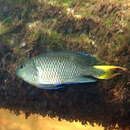Diagnostic Description
provided by Fishbase
Description: Overall dark brown, caudal fin and posterior dorsal and anal fins yellow. Margin of suborbital exposed. Body depth 2.3-2.5 in SL (Ref. 90102)
Life Cycle
provided by Fishbase
Oviparous, distinct pairing during breeding (Ref. 205). Eggs are demersal and adhere to the substrate (Ref. 205). Males guard and aerate the eggs (Ref. 205).
Morphology
provided by Fishbase
Dorsal spines (total): 13; Dorsal soft rays (total): 11 - 12; Analspines: 2; Analsoft rays: 11 - 12
Trophic Strategy
provided by Fishbase
Occurs inshore (Ref. 75154). Inhabits mangroves, estuaries, lower reaches of freshwater streams, and harbors with freshwater discharge. Also found in pure fresh water, but always within a few kilometers of the sea (Ref. 2847). Diurnal species (Ref. 52881).
- Recorder
- Drina Sta. Iglesia
Biology
provided by Fishbase
Adults inhabit mangroves, estuaries, lower reaches of freshwater streams, and harbors with freshwater discharge. Also found in pure fresh water, but always within a few kilometers of the sea (Ref. 2847). They occur in brackish waters of coastal embayments and mangrove estuaries (Ref. 44894). Spawning may take place in both brackish and fresh waters (Ref. 2847). Oviparous, distinct pairing during breeding (Ref. 205). Eggs are demersal and adhere to the substrate (Ref. 205). Males guard and aerate the eggs (Ref. 205). Diurnal species (Ref. 52881).
- Recorder
- Estelita Emily Capuli
Importance
provided by Fishbase
fisheries: minor commercial; price category: unknown; price reliability:
- Recorder
- Estelita Emily Capuli
分布
provided by The Fish Database of Taiwan
分布於印度-西太平洋區,自東非與印尼到索羅門群島,北至日本、台灣,南至澳洲北部與萬那杜。另外帛琉及新加勒多尼亞也有記錄。台灣北部、西南部等沿岸礁區較常見。
利用
provided by The Fish Database of Taiwan
小型之雀鯛,無食用價值。有人將其作觀賞魚之用。
描述
provided by The Fish Database of Taiwan
體呈橢圓形而側扁,標準體長為體高之2.2-2.6倍。吻短而鈍圓。口中型;兩頜齒兩列,小而呈圓錐狀。眶前骨具鱗,眶下骨具鱗,下緣平滑;前鰓蓋骨後緣多少呈鋸齒。體被櫛鱗;鼻部具鱗;側線之有孔鱗片16-17個。鰓耙數21-23。背鰭單一,軟條部略延長而呈尖形,硬棘
XII-XIII,軟條11-12;臀鰭硬棘II,軟條10-11;胸鰭鰭條17-19;尾鰭深叉形,上下葉末端延長呈絲狀。體呈褐色;鰓蓋上緣近側線處具一小黑點。背、臀鰭後半部有時為淡白至黃色,通常僅在背鰭基底末端具一個白色斑點;胸鰭透明,基底上緣具一稍大黑點;尾鰭基部暗褐色,且延伸至上下葉之外緣,中間部分則為淡白至黃色。
棲地
provided by The Fish Database of Taiwan
主要棲息於紅樹林、河口、淡水溪流的下游與有淡水流注的港灣。也可發現於純粹的淡水域,但通常是在離岸幾公里內的海水域。產卵則可能在半鹹淡水與淡水中發生。
Neopomacentrus taeniurus
provided by wikipedia EN
- license
- cc-by-sa-3.0
- copyright
- Wikipedia authors and editors
Neopomacentrus taeniurus: Brief Summary
provided by wikipedia EN
Neopomacentrus taeniurus (freshwater demoiselle) is a brackish and freshwater species of damselfish found in the western and central Indo-Pacific.

- license
- cc-by-sa-3.0
- copyright
- Wikipedia authors and editors
Description
provided by World Register of Marine Species
Inhabits mangroves, estuaries, lower reaches of freshwater streams, and harbors with freshwater discharge.
Froese, R. & D. Pauly (Editors). (2023). FishBase. World Wide Web electronic publication. version (02/2023).
- license
- cc-by-4.0
- copyright
- WoRMS Editorial Board


